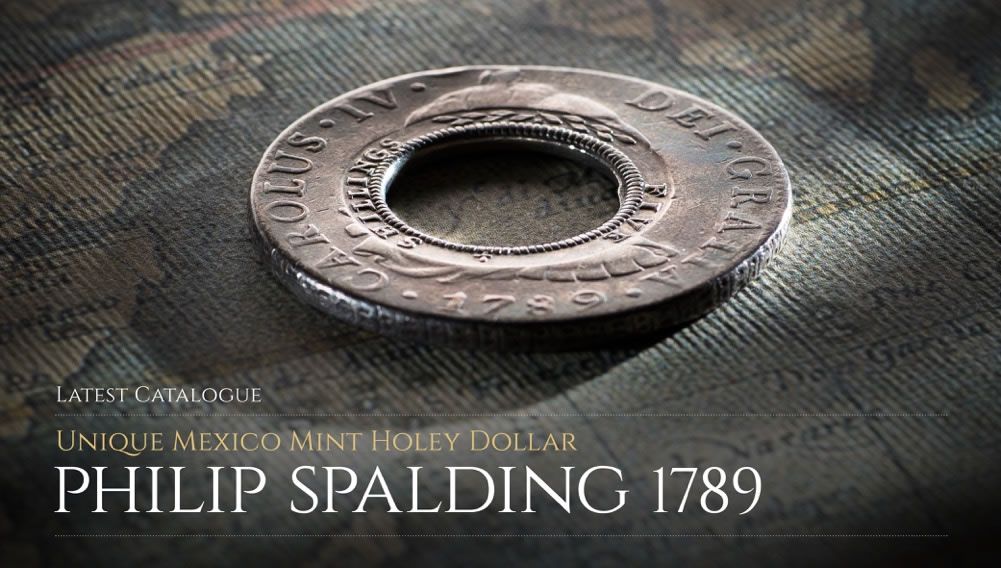The Holey Dollars of the late Philip Spalding.

We have just acquired two Holey Dollars from the collection of the late Philip Spalding. Both are rare, one of them is unique. And both are affordable. They were held by the Spalding family for more than four decades.
The two coins are featured in Browse & Buy. And in our latest Catalogue.
Both Holey Dollars were struck from Spanish silver dollars dated 1789. And each Holey Dollar depicts the portrait of the deceased monarch King Charles III, who died in 1788.
The first Holey Dollar is referenced 1789/1 in the Mira Noble book ‘The Holey Dollars of New South Wales’ and is a unique type of Mexico Mint Holey Dollar.
The background to this coin (1789/1) is as follows.
The Spanish King Charles III died in December 1788. The normal protocols would see the removal of the monarch’s portrait from his coinage, and its replacement with the effigy of the new king. But the news of the death of Charles III did not reach the Spanish colonies until March 1789.
The colonial mints unknowingly continued to produce coinage with the legend and portrait of the deceased king oblivious to the death of their monarch.
This Holey Dollar was struck from a silver dollar dated 1789 and depicts the portrait of the deceased monarch King Charles III. It also features the legend of the deceased monarch.
Of the surviving Holey Dollars, only two were struck from silver dollars that feature the legend and portrait of the deceased King Charles III.
This particular piece has ties to the Mexico Mint. The other Holey Dollar has ties to the Lima Mint making each a unique type and thus very sought after.
The second Holey Dollar is referenced 1789/2 in the Mira Noble book ‘The Holey Dollars of New South Wales’ published in 1988.
The background to this coin (1789/2) is as follows.
This Holey Dollar was struck from a silver dollar dated 1789 and depicts the portrait of the deceased monarch King Charles III, who died one year earlier, in 1788. It also features the legend Carolus IV, to acknowledge the new monarch, thereby differentiating it from the previous Holey Dollar.
This Holey Dollar is one of only eight privately held examples that depict the portrait of Charles III and the legend Carolus IV.
The mints of the Spanish colonies were prolific producers of silver coinage. Eager to maintain production of silver coins to flow into Spanish coffers, a Royal decree granted the colonial mints the right to continue striking coins with the portrait of the deceased King Charles III. The legend was however amended to the non-traditional Carolus IV to acknowledge the new monarch Charles IIII.
In 1791, the official portrait of Charles IIII appeared on the Spanish Silver Dollar for the first time and the legend reverted to the traditional format of Charles IIII.
Together these Holey Dollars chronicle the limitations of communications in this era and the challenges of the colonial mints wishing to maintain silver coin production while at the same time observing the currency protocols required for the passing of a monarch.
Both Holey Dollars are photographed and detailed in Spalding’s book, “The World of the Holey Dollar”. They were highly regarded by Spalding to the extent that they were featured in his book, in the chapter titled ‘The Top Dollars’, page 209 and 210.
Philip Spalding
Philip Spalding’s passion for the Holey Dollar extended far beyond ownership. He authored what is still to this day regarded as the ultimate reference on the history of Australia’s Holey Dollar. Published in 1973, ‘The World of the Holey Dollar’ is viewed as his greatest legacy.
His contributions to the industry, and the nation, was further evidenced with a donation to the State Library of New South Wales of one of the finest pieces from his collection. The coin was the very famous Charles IIII Seville Mint Holey Dollar. It is one of only two Holey Dollars that has ties to the mint in Seville, Spain.
History of the Holey Dollar
The narrative of the 1813 Holey Dollar, is as much about the Spanish Empire, as it is about Governor Macquarie’s attempt to introduce Australia’s first circulating coinage. It is a story that takes us on a journey through time and across continents.
The Holey Dollar, and let’s not forget its partner the Dump, are Australia’s first coins. Both were created in 1813 and involved a two part minting process. The first part of the process occurred when convicted forger William Henshall cut a hole in the centre of 40,000 Spanish Dollars, imported by Governor Lachlan Macquarie.
In so doing Henshall created two pieces of silver out of each single dollar: the first piece having a donut configuration and the second the inner circular disc that was punched out of the centre of the donut.
The second phase of the minting process required Henshall to officially over-stamp the two pieces of silver with the date, 1813, the value and the issuing authority of New South Wales.
This was the point at which the two pieces of the mutilated silver dollar were converted into the Holey Dollar and Dump and became Australia’s very first coins.
Macquarie wasn’t fussy about his shipment of 40,000 Spanish silver dollars. No protocols were set down for their quality or their dates. Nor did he care whether they were minted in Spain or the Spanish colonies of Mexico, Peru or Bolivia.
The silver dollars imported by Macquarie, and ultimately the Holey Dollars that were created from them, chart the course of the Spanish monarchs commencing with Ferdinand VI, Charles III, Charles IIII and Ferdinand VII including the tumultuous period in 1808 when Ferdinand VII exited the throne to be replaced by Joseph Bonaparte, brother of Napoleon Bonaparte.
© Copyright: Coinworks